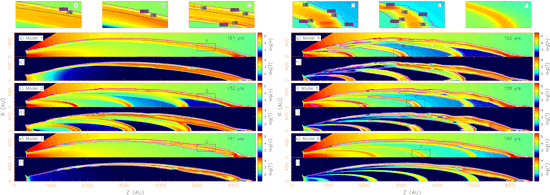|
Image Credit: Lee et al.

Simulations of our CFW models from 1 to 6, at the age of ~160 yr. Parts (a), (c), (e), (g), (i), and (k) show the number density of hydrogen nuclei in logarithmic scale. Parts (b), (d), (f), (h), (j), and (l) show the temperature in logarithmic scale. The molecular fractions f = 0.1 (white line) and f = 0.49 (magenta line) are shown to outline the distribution of molecular gas. The separation between the AGB wind and the CFW is shown by the color tracer c = 0.5 (gray line, at which half is AGB wind and half is CFW). The CFW is atomic at 10,000 K in models 1 and 2, while is molecular at 1000 K in models 3–6. The CFW is steady in models 1 and 3, while is pulsed with A = 0.5 in models 2 and 4, A = 0.3 in model 5, and A = 0.1 in model 6. Parts (A)−(F) show respectively the blow-ups for the regions in the boxes (A)−(F).
|
| Collimated fast winds (CFWs) have been proposed to operate during the post asymptotic giant branch (post-AGB) evolutionary phase (and even earlier during the late AGB phase), responsible for the shaping of preplanetary nebulae (PPNs) and young planetary nebulae (PNs). We applied the CFW models to the well-studied PPN CRL 618. We compared our CFW models with optical observations of CRL 618 in atomic and ionic lines and found that a CFW with a small opening angle can readily reproduce the highly collimated shape of the northwestern (W1) lobe of CRL 618 and the bowlike structure seen at its tip (Lee et al 2003). We also compared our CFW models with recent observations of CRL 618 in CO J = 2–1, J = 6– 5, and H2 1–0 S(1) (Lee et al. 2009). In our models, limb-brightened shell structures are seen in CO and H2 at low velocity (LV) arising from the shocked AGB wind in the shell, and can be identified as the LV components in the observations. However, the shell structure in CO J = 2–1 is significantly less extended than that seen in the observations. None of our models can properly reproduce the observed high-velocity (HV) molecular emission near the source along the body of the lobe. In order to reproduce the HV molecular emission in CRL 618, the CFW is required to have a different structure. One possible CFW structure is the cylindrical jet, with the fast wind material confined to a small cross section and collimated to the same direction along the outflow axis. |
 asiaa.sinica.edu.tw Media Request: epo
asiaa.sinica.edu.tw Media Request: epo asiaa.sinica.edu.tw
asiaa.sinica.edu.tw 